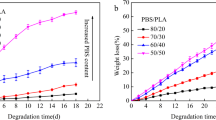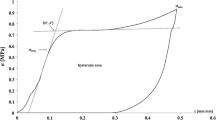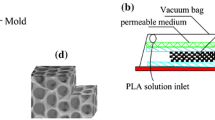Abstract
Porous PLGA/PVA scaffolds as hydrophilized PLGA scaffolds for tissue engineering applications were fabricated by a novel melt-molding particulate leaching method (non-solvent method). The prepared scaffolds exhibited highly porous and open-cellular pore structures with almost same surface and interior porosities (pore size, 200–300 μ m; porosity, about 90%). The in vitro degradation behavior of the PLGA and PLGA/PVA scaffolds was compared at 37∘C in PBS (pH 7.4) with and without the solution change everyday to see the effect of solution pH as well as scaffold hydrophilicity on the degradation behavior. The changes in dimension, molecular weight, mechanical properties (maximum load and modulus), and morphology of the scaffolds were examined with degradation time. The degradation behavior of the PLGA and PLGA/PVA scaffolds was further investigated in vivousing a rat model (subcutaneously implantation). It was observed that both PLGA and PLGA/PVA scaffolds in decreasing pH condition (PBS no change) showed faster degradation than those in constant pH condition (PBS change everyday), owing to the enhanced intramolecular depolymerization by the increment of chain hydrophilicity caused by carboxylate groups as well as the autocatalysis of carboxylic acids accumulated in the solution by the cleavage of PLGA backbone ester bonds. The scaffolds in vivo condition also showed faster degradation than those in vitro, probably due to the aid of foreign body giant cells or enzymes. The PLGA/PVA scaffold showed slightly faster degradation than the PLGA scaffold for both in vitro and in vivo conditions.
Similar content being viewed by others
References
X. S. WU, in Encyclopedic Handbook of Biomaterials and Bioengineering, edited by D. L. Wise, D. J. Trantolo, D. E. Altobelli, M. J. Yaszemski, J. D. Gresser and E. R. Schwartz, (Marcel Dekker, New York, 1995) p. 1015.
A. G. MIKOS, G. SARAKINOS, S. M. LEITE, J. P. VACANTI and R. LANGER, Biomater. 14(1993) 323.
A. G. MIKOS, A. J. THORSEN, L. A. GZERWONKA, Y. BAO, R. LANGER, D. N. WINSOLW and J. P. VACANTI, Polym. 35 (1994) 1068.
C. SCHUGENS, V. MAQUET, C. GRANDFILS, R. JEROME and P. TEYSSIE, J. Biomed. Mater. Res. 30 (1996) 449.
Y. S. NAM and T. G. PARK, ibid. 47 (1999) 8.
H. LO, S. KADIYALA, E. GUGGINO and K. W. LEONG, ibid. 30(1996) 475.
K. WHANG, C. H. THOMAS, K. E. HEALY and G. NUBER, Polym. 36 (1995) 837.
L. D. HARRIS, B. S. KIM and D. J. MOONEY, J. Biomed. Mater. Res. 42 (1998) 396.
Y. S. NAM, J. J. YOON and T. G. PARK, J. Biomed. Mater. Res. 53 (2000) 1.
A. G. A. COOMBES and J. D. HECKMAN, Biomater. 13 (1992) 217.
A. G. MIKOS, Y. BAO, L. G. CIMA, D. E. INGBER, J. P. VACANTI and R. LANGER, J. Biomed. Mater. Res. 27 (1993) 183.
A. PARK, B. WU and L. G. GRIFFITH, J. Biomater. Sci. Polym. Edn. 9 (1998) 89.
D. MOONEY, D. F. BALDWIN, N. P. SUH, J. P. VACANTI and R. LANGER, Biomater. 17 (1998) 1417.
S. H. OH, S. G. KANG, S. H. CHO, E. S. KIM and J. H. LEE, ibid. 24 (2003) 4011.
A. G. MIKOS, M. D. LYMAN, L. E. FREED and R. LANGER, ibid. 15 (1994) 55.
L. E. FREED, J. C. MARQUIS, A. NOHRIA, J. EMMANUAL, A. G. MIKOS and R. LANGER, J. Biomed. Mater. Res. 27 (1993) 11.
L. E. FREED, G. VUNJAK-NOVAKOVIC, R. J. BIRON, D. B. EAGLES, D. C. LESNOY, S. K. BARLOW and R. LANGER, Biotechnology 12 (1994) 689.
S. LI, J. Biomed. Mater. Res. 48 (1999) 342.
A. J. COURY, R. J. LEVY, C. R. MCMILLIN, Y. PATHAK, B. D. RATNER, F. J. SCHOEN, D. F. WILLIAMS and R. L. WILLIAMS, in Biomaterials Science: An Introduction to Materials in Medicine, B. D. Ratner, A. S. Hoffman, F. J. Schoen and J. E. Lemons edited by, (Academic Press, New York, 1996) p. 243.
H. YOSHIMOTO, Y. M. SHIN, H. TERAI and J. P. VACANTI, Biomater. 24 (2003) 2077.
C. G. PITT, Y. CHA, S. S. SHAH and K. J. ZHU, J. Control. Rel. 19 (1992) 189.
L. LU, S. J. PETER, M. D. LYMAN, H. L. LAI, S. M. LEITE, J. A. TAMADA, S. UYAMA, J. P. VACANTI, R. LANGER and A. G. MIKOS, Biomater. 21 (2000) 1837.
Author information
Authors and Affiliations
Corresponding author
Additional information
Author to whom all correspondence should be addressed.
Rights and permissions
About this article
Cite this article
Oh, S.H., Kang, S.G. & Lee, J.H. Degradation behavior of hydrophilized PLGA scaffolds prepared by melt-molding particulate-leaching method: Comparison with control hydrophobic one. J Mater Sci: Mater Med 17, 131–137 (2006). https://doi.org/10.1007/s10856-006-6816-2
Received:
Accepted:
Issue Date:
DOI: https://doi.org/10.1007/s10856-006-6816-2




